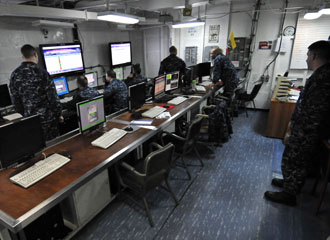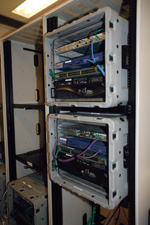NGEN Race Heats Up
 |
Sailors monitor computer networks aboard the amphibious command ship USS Mount Whitney. For its Next-Generation Enterprise Network (NGEN), the U.S. Navy is maintaining a degree of control over the network that will be provided by industry. |
Cost, security and the transition from the existing network to a new one are the top criteria for determining which company wins the contract for the U.S. Navy’s successor to the Navy/Marine Corps Intranet. The Next Generation Enterprise Network, which is estimated will cost the Navy several billion dollars, would take a different contracting approach than its predecessor. This difference is only one of the departures from precedent that characterize the new network.
The competition for that new network is entering the home stretch. The Navy issued its final draft request for proposals (RFP) in early October, and the formal RFP is slated to be issued later this month.
The contract approach for the Next Generation Enterprise Network, or NGEN, differs substantially from that of the Navy/Marine Corps Intranet (NMCI). The NMCI contract called for a commercial firm to determine and provide network services to the Navy and the U.S. Marine Corps. For NGEN, the government wields control over the network.
In charge of the NGEN effort is Capt. Shawn P. Hendricks, USN, the program manager for PMW-205 Naval Enterprise Networks. “In my opinion, there is no more important program than NGEN,” he declares. “It is the way the Navy and Marine Corps communicate.
“This has never been done before,” the captain states. “This is groundbreaking. Success here is important for the entire information technology industry. We have to prove we can do this, and now is the right time.”
Capt. Hendricks notes that the NMCI is the conglomeration of many disparate networks that had varying levels of security and services. It is not a single operating network of hundreds of thousands of users with the across-the-board security common today. “So, we’re re-competing something that has never been competed before,” he says.
To win the contract, bidders must address several points, but first and foremost is to ensure a seamless transition from the NMCI to NGEN. This includes seamless security that ensures no gap emerges during the transition. Bidders must show a transition plan that will work for both networks. To Capt. Hendricks, the importance of the transition plan cannot be overstated.
“We can’t drop it while we pass it,” he warrants. “I get phone calls when the network goes down for 10 minutes. I can’t afford it. The transition must be seamless—my customers expect that, and I expect to deliver that.
“To not have NGEN for a day would have a huge operational impact,” the captain continues. “I don’t think you can say that about any other single system. I will hold the contractors accountable for making sure that we get there,” he emphasizes.
Over its life, NGEN must continue to evolve to be more efficient, more secure and more cost effective, Capt. Hendricks says. Potential contractors must show how they will reduce costs over the five years of contract evolution. “The natural evolution of information technology is that service improves and price goes down or at least stays the same,” the captain states. “We have to tech-refresh the network. About 25 percent of the network every year is up for replacement because [hardware or software] is no longer supportable, and we have to replace it with something else. I expect that ‘something else’ to be either more capable at the same price or the same capability at lower cost,” he declares.
“I’m not going to tell them [the contractors] how to deliver the network. I’m going to give them the requirement. It ends where they decide it can end.”
Capt. Hendricks points out that the NMCI contract was a straight Federal Acquisition Regulation (FAR) Part 12 commercial services contract. Services are provided for a fixed price, and the customer does not have much insight into any costs other than that fixed price. NGEN, as a FAR Part 15 acquisition, has much more visibility into the cost of its segments and the services inside of each segment. And, the acquisition authority for NGEN is the undersecretary of defense for acquisition and logistics, the captain points out.
The contract for NGEN will be a lowest-price, technically acceptable contract. So, if a bid meets all the technical criteria, the winning determinant will be price, he says.
The biggest difference between NGEN and its NMCI progenitor is that the NMCI was a service provided by the contractor. NGEN will be controlled by the government. The degree to which the government will run NGEN is uncertain, but it will exercise its choice as needed.
 |
The deployable site transport boundary is a portable network that enables as many as 200 deployed Marines to use the Navy/Marine Corps Intranet (NMCI). The Marine Corps has begun its first steps to transition from NMCI to NGEN through its Marine Corps Network Operations Security Center in Quantico. |
With the NMCI today, the government has the ability to command and control the network through the contractor. However, this approach is not as efficient as it will be under NGEN, the captain offers. This is because the government will own all the hardware on NGEN. So, the government will decide on any hardware changes, and it will have the necessary insight to ensure cost-effective delivery of the secure network.
Turning over control of the network from industry experts to Navy engineers should not present any problems in terms of expertise, Capt. Hendricks offers. The Navy has the skilled personnel needed to manage the network, and it already has begun shifting command and control of the NMCI to network operations personnel in Norfolk. The Marine Corps already has transitioned its network command and control to the Marine Corps Network Operations Security Center in Quantico, Virginia, he reports. A program known as Transition Now has personnel operating the NMCI in as similar a manner as anticipated for NGEN when the new network becomes operational. This will ensure that the rollover into NGEN will not involve wholesale changes in processes and people, regardless of the winning contractor.
A few changes mark the RFP process and approach to NGEN. The Navy has adopted a single RFP for transport and enterprise services, and it may select different contractors for each or one for both. If one contractor is selected for both, the two elements still would be segmented with a clear demarcation so that the Navy would be able to understand the network’s composition.
The Navy and the Marine Corps will continue to own their end-user hardware. Security operations and oversight will not be a part of the NGEN contract; instead they will be conducted by organic naval assets through the Navy’s Fleet Cyber Command/Tenth Fleet.
The NGEN office has worked extensively to obtain input from industry on both the process and the product. Capt. Hendricks relates that he has met with any firms that requested a meeting. And, the draft RFPs and various industry engagements, including industry days, have generated a great deal of feedback from the commercial sector. Meetings with industry have been candid and have gone well, the captain notes. “We seek industry’s expertise. No one has ever done this before,” he states.
One key step is that he solicited a one-page synopsis from potential bidders on the draft RFP. This approach addresses the issue of too much feedback: when asked, a company may submit dozens or even hundreds of comments; and however valid they may be, no official can absorb all of them from each company. The captain explains that he requested each company to assemble on one page the points that it wants him to know personally. “I’ve given them my commitment that I will read every one of those,” he declares.
The captain continues that the Navy has tried to increase industry’s insight into what will be put into the RFP. The tools for this effort include two official industry days, acquisition concepts released over the summer, and access to intellectual property and a technology data package released in June. The Navy has incorporated some of the comments from the acquisition concepts.
“We [the Navy] are not the warehouse of all the good ideas,” Capt. Hendricks explains. “I look to [members of] industry to make sure that, when I release the RFP, they can propose a quality product against my RFP.
“And I want to make sure that when the RFP comes out in December that I get some solid proposals—not ‘well, I don’t have enough information to propose,’” he says. “I want the best [companies] coming with their best.”
One area of focus is the clarity of the performance work statement and the technical factors needed for consideration of the NGEN contract award—Sections L and M, the captain offers. But, overall, industry’s questions largely have focused on the product more than the process, he allows. Businesses are looking for clarity to ensure that they understand what the Navy is seeking in NGEN. Many of the questions from industry have focused on how NGEN will differ from the NMCI, which is a services contract under a single contract. Capt. Hendricks is unambiguous about how NGEN stands out in this comparison.
“The government wants the insight into what it takes to deliver the specific services as segmented under NGEN—what does it cost, what are the interfaces, what are the key factors—so that [the Navy] continues to have effective command and control and the ability to recompete what we want and when we want it, as opposed to having to compete the whole thing all at once, every time, without having great insight into the individual cost components within the services offered under NGEN,” he elaborates.
WEB RESOURCES
SPAWAR NGEN: www.public.navy.mil/spawar/PEOEIS/NEN/NGEN/Pages/default.aspx



Comments